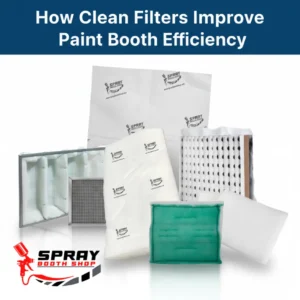
How Clean Filters Boost Paint Booth Performance and Erase Finish Defects
In professional finishing, perfection isn’t just about the gun, paint, or painter—it starts with the air. Inside every high-performing spray booth, clean, well-maintained filters quietly set the stage for flawless coats, predictable airflow, and safe, efficient operations. This article explains how intake, exhaust, and specialty filters work together to block contaminants, capture overspray, protect equipment, and reduce energy waste—while also highlighting the telltale signs of filter fatigue and the maintenance habits that keep quality high and rework low. If you want shinier results, faster throughput, and lower costs, begin with the simplest upgrade of all: cleaner filters.
The Unseen Foundation of Flawless Finishes
Before exploring the technical details, it’s essential to understand the fundamental role of the paint booth and the pervasive threats that undermine its purpose. This controlled environment is designed for one primary reason: to isolate the painting process from the outside world and manage its byproducts.
Why the Paint Booth Is the Heart of Quality Finishing
A paint booth is an engineered enclosure that provides a clean, temperature-controlled, and well-lit space for applying coatings. Its primary function is to create a contaminant-free environment that allows for a smooth, even application of paint. Proper ventilation is the heart of this function, designed to direct airflow in a way that carries away overspray and volatile organic compounds (VOCs), ensuring both a high-quality finish and worker safety.
The Silent Saboteurs: Contaminants, Dust, and Overspray
The greatest enemies of a perfect paint finish are airborne contaminants. Dust, debris, hair, and fibers can settle on a wet surface, creating imperfections that require costly and time-consuming rework. Within the booth, the painting process itself generates its own contaminant: overspray. These atomized paint particles, if not effectively captured, can recirculate and settle on the finished piece or clog vital equipment, compromising both quality and efficiency.
Proper Filtration: Your Key to Peak Performance
This is where the paint booth filtration system comes into play. It acts as the lungs of the operation, breathing in clean air and exhaling filtered air. A high-performance filtration system is the first and most effective line of defense against both external debris and internal overspray. By ensuring the air entering and leaving the spray booth is clean, these filters directly enable flawless paint finishes, enhance operational efficiency, and maintain a safe working environment.
Understanding Your Booth’s Filtration System: The Lungs of Your Operation
A paint booth’s air filtration system is a multi-stage process, with different types of filters working in concert to handle specific tasks. The increasing technical demands are reflected in the growth of the global market for these components, with the air filters market valued at USD 16.00 billion in 2024. Understanding each component is key to effective maintenance.
Intake Filtration: Protecting Your Process from External Contaminants
Intake filters are responsible for cleaning the air that enters the paint booth. Positioned in the ceiling or intake plenum, they capture dust, pollen, and other particulate matter from the ambient air before it can reach the painting area. A clean intake filter ensures that only the atomized paint from the spray gun enters the booth, setting the stage for a defect-free finish.
Exhaust Filtration: Capturing Overspray and Maintaining Air Quality
As the ventilation system pulls air through the booth, it carries overspray with it. Exhaust filters, located in the booth’s floor or walls, are designed to capture these sticky paint particles before the air is vented outside. These filters are critical for preventing environmental contamination, complying with regulations, and protecting the exhaust fan and ductwork from a buildup of paint, which can become a fire hazard and impede airflow.
Specialty Filters: Activated Carbon Filters for Solvents/VOCs
For operations using solvent-based paints, which can contain up to 50% VOCs according to Ultrimax, specialty filters are often necessary. Activated carbon filters use adsorption to trap VOCs and chemical fumes, removing harmful odors and pollutants from the exhausted air. This is crucial for meeting stringent environmental regulations and ensuring the safety of personnel in and around the facility.
Filter Media Matters: Fiberglass, Polyester, and Their Applications
Paint booth filters are not one-size-fits-all. The media they are made from determines their efficiency and capacity. Fiberglass media is a common and cost-effective choice for exhaust filters, offering good overspray-capturing capabilities. Polyester media, often used in multi-layered filters, provides higher efficiency and can capture finer particles, making it suitable for both intake and advanced exhaust applications. The choice of media depends on the type of paint used, production volume, and specific air quality requirements.
The Interplay of Filter Types for Comprehensive Air Filtration
No single filter can do it all. A truly effective system relies on the interplay between different filter stages. Pre-filters can be used to capture larger particles, extending the life of more expensive final-stage intake or exhaust filters. The combination of intake, exhaust, and specialty filters creates a comprehensive barrier that protects the paint job, the equipment, the employees, and the environment.
How Clean Paint Booth Filters Elevate Finish Quality
The quality of a paint finish is a direct reflection of the cleanliness of the environment in which it was applied. The connection between filter maintenance and finish quality is undeniable, impacting everything from microscopic surface imperfections to overall customer perception, especially within the vast automotive paint market.
Eliminating Paint Defects: Preventing Dust, Debris, and Contaminants
The most obvious benefit of clean filters is the prevention of particulate contamination. When intake filters are clean, they effectively block dust and debris from entering the booth. When exhaust filters are functioning properly, they prevent captured overspray from flaking off and re-entering the airflow. This diligence eliminates common paint defects like “dust nibs” or “fisheyes,” reducing the need for extensive polishing, buffing, or complete repainting.
Ensuring Contaminant-Free Surfaces for Optimal Adhesion and Durability
Beyond visible defects, microscopic contaminants can interfere with the chemical bond between the paint and the substrate. A clean, particulate-free surface is essential for achieving maximum adhesion. Proper filtration ensures that the surface remains pristine throughout the application and initial curing phase, leading to a more durable and long-lasting finish that resists chipping and peeling.
Achieving Consistent Color Matching and a Flawless Paint Finish
Consistent airflow, which is only possible with clean filters, is crucial for achieving uniform paint application and color matching. Clogged filters can create turbulence or “dead spots” within the spray booth, causing uneven paint film thickness. This can lead to variations in color and gloss, resulting in a mismatched or mottled appearance. Clean filters ensure laminar airflow, which helps the technician apply a consistent coat every time.
The Impact on Customer Satisfaction and Product Reputation
Ultimately, the quality of the paint finish is what the customer sees. A flawless, high-gloss finish conveys quality, craftsmanship, and attention to detail. Conversely, a finish marred by dust or imperfections can damage a brand’s reputation and lead to customer dissatisfaction. Proactive filter maintenance is a direct investment in the final product quality and, by extension, in the business’s reputation.
Boosting Booth Efficiency and Overall Performance
While finish quality is a primary driver, the benefits of clean filters extend deep into the operational efficiency of the entire painting process. A booth struggling with clogged filters is a booth that is wasting time, energy, and money.
Optimizing Airflow and Ventilation for Superior Results
The single most important factor for booth performance is airflow. Paint booths are designed to operate at a specific air velocity, typically around 100 feet per minute for open-face booths. This speed is optimal for capturing overspray and safely exhausting solvent fumes. Clogged filters dramatically increase resistance, forcing the fan to work harder to move less air. This reduction in airflow compromises overspray capture, leading to a dirtier booth and poorer finish quality.
Maximizing Energy Efficiency and Reducing Operational Costs
Restricted airflow has a significant impact on energy consumption. A fan motor struggling against high static pressure from dirty filters draws more electricity. In facilities like auto body shops, where approximately 40% of electricity is used to power equipment such as fans, this inefficiency can result in substantially higher utility bills. The paint finishing operation can account for up to 90% of a bodyshop’s fuel consumption, making filter-related efficiency paramount. Clean filters allow the ventilation system to operate as designed, minimizing energy draw and reducing operational costs.
Enhancing Workflow and Productivity
Proper airflow also plays a role in the paint curing process. Consistent, clean airflow helps to evacuate solvents from the painted surface more efficiently, leading to faster and more uniform curing times. This allows for a quicker turnaround, increasing overall shop productivity. Furthermore, avoiding rework caused by contamination saves countless hours of labor and materials, preventing unplanned downtime and keeping projects on schedule.
Extending the Lifespan of Your Paint Booth and Equipment
The strain placed on a ventilation system by clogged filters affects more than just the monthly energy bill. The fan motor must run harder and hotter, leading to premature wear and tear and an increased risk of failure. Additionally, poor overspray capture allows paint particles to accumulate on fan blades, in ductwork, and on other mechanical components, which can cause imbalances, reduce performance, and create potential safety hazards. Regular filter maintenance protects this significant capital investment.
When Your Filters Demand Attention
Proactive maintenance relies on knowing when to act. Recognizing the early warning signs of clogged filters allows you to address the issue before it impacts finish quality or operational efficiency.
Visual Cues of Filter Degradation
The most straightforward method of inspection is visual. Intake filters will show discoloration from trapped dust and dirt. Exhaust filters will become visibly loaded with paint overspray. Look for areas where the media is sagging, torn, or completely saturated. These are clear indicators that the filter’s performance is compromised and replacement is needed.
Performance Indicators of Clogged Filters
Performance degradation is a key sign. You might notice that overspray is not clearing from the booth as quickly as it used to, or a fine layer of dust settles on surfaces shortly after cleaning. Technicians may report changes in how the spray gun behaves due to altered airflow patterns. These are tangible signs that the ventilation system is struggling.
Monitoring Tools: Pressure Gauges and Manometers as Diagnostic Aids
For a more scientific approach, pressure gauges or manometers are indispensable tools. These devices measure the pressure difference across a filter bank. A clean filter has a low initial pressure drop. As it loads with contaminants, the pressure drop increases. By establishing a baseline reading with clean filters and knowing the manufacturer’s recommended replacement point, you can change filters based on precise data rather than guesswork.
The Impact of Filter Clogging on Paint Quality and Rework Rates
An increase in rework is a lagging but powerful indicator of filter issues. If you find your team is spending more time denibbing, polishing, or completely repainting jobs due to contamination, it is highly probable that your filtration system is failing. Tracking rework rates can provide a clear financial justification for a more rigorous filter maintenance schedule.
Establishing a Proactive Filter Maintenance Program
Reacting to problems is always more expensive than preventing them. A structured, proactive filter maintenance program transforms a necessary chore into a strategic advantage, ensuring consistent quality, safety, and efficiency.
The Importance of a Regular Maintenance Schedule
A formal maintenance schedule removes ambiguity. Based on production volume and the types of coatings used, a regular cadence for filter inspection and replacement should be established and documented. This could be weekly, monthly, or based on the number of jobs completed. Consistency is key to preventing the performance degradation that leads to larger problems.
Best Practices for Filter Replacement and Installation
Proper installation is just as important as the filter itself. When replacing filters, ensure the new ones are seated correctly and that there are no gaps or bypasses where contaminated air can sneak through. Always use filters that meet the original equipment manufacturer’s specifications for size and efficiency to ensure the paint booth operates as designed. The booth should be thoroughly cleaned during a filter change-out to remove any accumulated dust or overspray.
Strategic Filter Replenishment and Inventory Management
Running out of replacement filters can cause costly downtime. A smart maintenance program includes strategic inventory management. By tracking usage rates, you can determine optimal reorder points and ensure you always have the necessary filters on hand. This prevents delays and ensures that the maintenance schedule can be followed without interruption, keeping your entire painting operation running smoothly.
Clean Filters, Better Finishes: Max Paint Booth Performance
In the complex process of achieving a perfect paint finish, the humble filter plays a foundational and non-negotiable role. It is the gatekeeper of quality, the engine of efficiency, and the guardian of safety. The connection is direct and irrefutable: clean filters enable stable, designed airflow. This stable airflow ensures superior overspray capture, minimizes energy consumption, prevents contaminant-related defects, and guarantees a safer work environment.
Moving forward, the key is to shift from a reactive to a proactive mindset. Implement a rigorous maintenance schedule, utilize monitoring tools like manometers to make data-driven decisions, and maintain a strategic inventory of replacement filters. By treating your paint booth’s filtration system not as an afterthought but as a critical asset, you invest directly in higher quality finishes, increased productivity, lower operational costs, and a stronger reputation in a competitive market. Ultimately, the path to a flawless finish begins and ends with clean air.
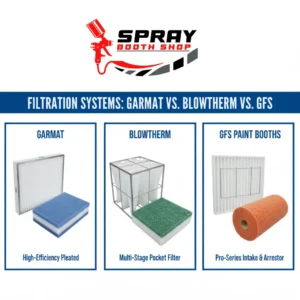 Garmat vs. Blowtherm vs. GFS Paint Booths: Which Filters Do They Use?
Garmat vs. Blowtherm vs. GFS Paint Booths: Which Filters Do They Use? 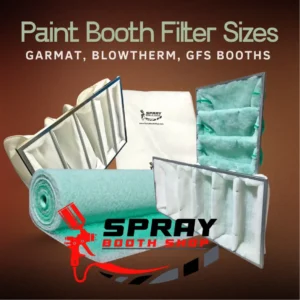 Paint Booth Filter Sizes Explained: Finding the Perfect Fit for Garmat, Blowtherm, and GFS Booths
Paint Booth Filter Sizes Explained: Finding the Perfect Fit for Garmat, Blowtherm, and GFS Booths  The Differences Between Pre-Filters, Intake Filters, and Exhaust Filters
The Differences Between Pre-Filters, Intake Filters, and Exhaust Filters  Your Step-by-Step Guide: Installing a New Paint Booth Filter Flawlessly
Your Step-by-Step Guide: Installing a New Paint Booth Filter Flawlessly 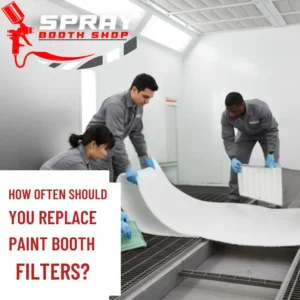 How Often Should You Replace Paint Booth Filters? A Complete Breakdown by Booth Type
How Often Should You Replace Paint Booth Filters? A Complete Breakdown by Booth Type